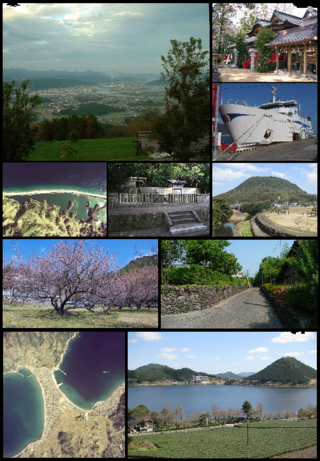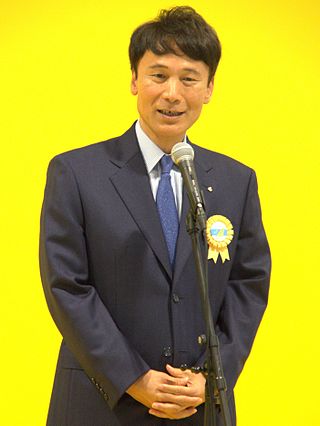
Kagoshima City, is the capital city of Kagoshima Prefecture, Japan. As of 31 July 2024, the city had an estimated population of 583,966 in 285,992 households, and a population density of 1100 persons per km2. The total area of the city is 547.61 km2 (211.43 sq mi).

Satsumasendai is a city located in Kagoshima Prefecture, Japan. As of 1 July 2024, the city had an estimated population of 90,918 in 46610 households, and a population density of 130 persons per km2. The total area of the city is 682.92 km2 (263.68 sq mi).

Kanoya is a city in Kagoshima Prefecture, Japan. As of 1 March 2024, the city had an estimated population of 98,367 in 46114 households, and a population density of 100 persons per km². The total area of the city is 448.15 km2 (173.03 sq mi). Kanoya is also popularly called the "Town of Roses".

Satsuma is a district located in Kagoshima Prefecture, Japan.

Nagashima is a town located in Izumi District, Kagoshima Prefecture, Japan. As of 31 January 2024, the town had an estimated population of 9618 in 4386 households, and a population density of 83 people per km2. The total area of the town is 116.19 km2 (44.86 sq mi).

Yūsui is a town located in Aira District, Kagoshima Prefecture, Japan.As of 31 March 2024, the town had an estimated population of 8,361 in 4600 households, and a population density of 58 persons per km2. The total area of the town is 144.29 km2 (55.71 sq mi). "Yūsui" literally means "spring water", referring to springs in the town.

Hioki is a city in Kagoshima Prefecture, Japan. As of 1 July 2024, the city had an estimated population of 46,348 in 22706 households, and a population density of 180 persons per km2. The total area of the city is 253.01 km2 (97.69 sq mi).

Utsunomiya Station is a railway station in the city of Utsunomiya, Tochigi Prefecture Japan, operated by the East Japan Railway Company. The station also is a freight depot for the Japan Freight Railway Company.

The Satsugū dialect, often referred to as the Kagoshima dialect, is a group of dialects or dialect continuum of the Japanese language spoken mainly within the area of the former Ōsumi and Satsuma provinces now incorporated into the southwestern prefecture of Kagoshima. It may also be collectively referred to as the Satsuma dialect, owing to both the prominence of the Satsuma Province and the region of the Satsuma Domain which spanned the former Japanese provinces of Satsuma, Ōsumi and the southwestern part of Hyūga. The Satsugū dialect is commonly cited for its mutual unintelligibility to even its neighboring Kyūshū variants, prompting the Max Planck Institute for Evolutionary Anthropology to classify it as a distinct language in the Japanesic branch in its Glottolog database. It shares over three-quarters of the Standard Japanese vocabulary corpus and some areal features of Kyūshū.

Adocus is an extinct genus of aquatic turtles belonging to the family Adocidae.

Satoshi Mitazono is a Japanese politician and journalist who is the former governor of Kagoshima Prefecture. He defeated the incumbent Yūichirō Itō at an election held on 10 July 2016.
The 2016 Kagoshima gubernatorial election was held on 10 July 2016 and contested by the three-term incumbent Yuichiro Ito and political journalist Satoshi Mitazono. Ito was denied a fourth term in office, as Mitazono received 55% of the vote following a campaign based primarily on change as well as opposition to the prefecture's operating nuclear power plant. The election was held on the same day as the national House of Councillors election, which helped increase voter turnout to 58.6%, compared to 43.8% at the previous election in 2012.

The Kagoshima Aquarium is a Public Aquarium of Kagoshima City located in Kagoshima Prefecture Kagoshima City Honkoshinmachi. It is a member of the Japanese Association of Zoos and Aquariums (JAZA).

The Pokémon Fossil Museum is a travelling exhibition based on the Pokémon media franchise, displaying illustrations and "life-size" sculpted renditions of the skeletons of fossil Pokémon, along with the actual fossils of the real-life prehistoric animals and other organisms on which they were based. The exhibit was created by the National Museum of Nature and Science and The Pokémon Company.

Amakusaichthys is an extinct genus of ichthyodectiform ray-finned fish which lived during the Late Cretaceous, known from two species A. goshouraensis from Kumamoto Prefecture in Japan and A. benammii from Chiapas in Mexico.

Yoshitsugu Kobayashi is a Japanese vertebrate paleontologist. He is a professor and the assistant director in Hokkaido University Museum. His major achievements include the description and naming of several dinosaurs from Japan, for example, Kamuysaurus, Yamatosaurus and Paralitherizinosaurus. He is also a research affiliate of Perot Museum of Nature and Science, a member of Jurassic Foundation, a councilor of Palaeontological Society of Japan.

"Satsuma-utsunomiya-ryu" is an undescribed plesiosaur known from Kyushu, Japan. This nickname is named after the former province name of the discovery site and the discoverer, Satoshi Utsunomiya. It is the oldest known elasmosaurid plesiosaur fossil in East Asia, dating back to approximately 100 million years ago. It is permanently exhibited at the Kagoshima Prefectural Museum.

Sasayamagnomus is a genus of neoceratopsian dinosaur from the Early Cretaceous (Albian) Ohyamashimo Formation of Hyogo prefecture, Japan. The genus contains a single species, S. saegusai. Type specimen is estimated to reach 80 centimetres (2.6 ft) long, although this specimen is not fully grown.

















